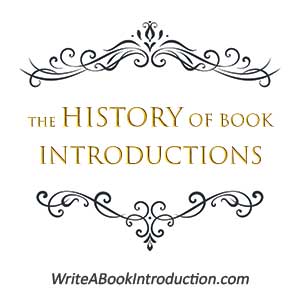The History and Evolution of Book Introductions
 This article about the history and evolution of book introductions includes fun facts about the origin and evolution of book introductions. Together we’ll take a fascinating tour of book introductions associated with oral traditions and storytelling, ancient texts, and contemporary works. This article is part of a series about how to write a book introduction, written by a former literary agent who’s helped 400+ authors get literary agents and/or traditional publishers.
This article about the history and evolution of book introductions includes fun facts about the origin and evolution of book introductions. Together we’ll take a fascinating tour of book introductions associated with oral traditions and storytelling, ancient texts, and contemporary works. This article is part of a series about how to write a book introduction, written by a former literary agent who’s helped 400+ authors get literary agents and/or traditional publishers.
What’s the History of Book Introductions?
The history of book introductions dates back to ancient texts, where prologues set context or invoked divine inspiration. Medieval works used introductions to frame scholarly or religious texts. During the Renaissance, introductions established authorial intent. Today, they engage readers, explain purpose, and outline structure, reflecting evolving literary and audience expectations.
Book Introductions: From Ancient Beginnings to Modern Craft
The practice of introducing a book has evolved over centuries, reflecting changes in literary culture, audience expectations, and publishing norms. The history of book introductions offers a fascinating glimpse into how authors have engaged readers and contextualized their work throughout history. From ancient prologues to the carefully crafted introductions of today, this website explores the development and significance of this crucial element of the book.
Ancient Beginnings: The Origins of the Book Introduction
Oral Traditions and Storytelling
- Before the written word, storytelling traditions often included preludes to set the stage for the tale. These introductions contextualized the story, invoked blessings, or connected the audience to the speaker.
- Example: Ancient epics like The Iliad and The Odyssey often began with invocations to the muse, signaling the story’s importance and seeking divine inspiration.
Prologues in Ancient Texts
- Early written works included introductory sections known as prologues, serving as precursors to modern introductions.
- Example: Plato’s dialogues and Aristotle’s treatises often began with prologues that outlined the purpose and scope of the philosophical discourse.
- Purpose: These prologues oriented readers to the topic, established the author’s credibility, and highlighted the relevance of the work.
The Medieval Era: Framing Sacred and Scholarly Texts
Religious Works
- During the medieval period, introductions often took the form of prefaces or dedicatory letters.
- Example: Biblical texts and theological works frequently included prefaces explaining their divine inspiration, purpose, or intended audience.
- Purpose: These introductions sought to legitimize the work as sacred or scholarly, ensuring its acceptance by religious authorities and audiences.
Scholarly Manuscripts
- In medieval Europe, introductions in scholarly manuscripts were used to outline the content and highlight the author’s qualifications.
- Example: The works of Thomas Aquinas often began with explanations of their academic intent and a summary of key arguments.
The Renaissance: Establishing Authority and Audience Connection
Rise of the Author’s Voice
- The Renaissance marked a shift toward author-centric introductions. Writers began using introductions to assert their authority, explain their creative intent, and connect with their audience.
- Example: Niccolò Machiavelli’s The Prince opens with a dedication to Lorenzo de’ Medici, framing the work as a guide for political leadership.
- Purpose: Authors sought to appeal directly to patrons or readers, solidifying their work’s relevance and value.
Printing Press Influence
- The invention of the printing press in the 15th century democratized access to books, prompting authors to use introductions to address a broader audience.
- Example: Prefaces and introductions began to include appeals to the general reader, emphasizing the universality of the content.
The Enlightenment and Beyond: Rational Structure and Reader Engagement
Logical Introductions
- Enlightenment authors embraced introductions as tools for structuring complex ideas and engaging rational readers.
- Example: Adam Smith’s The Wealth of Nations begins with a clear explanation of the book’s goals and its intended audience of scholars, policymakers, and merchants.
- Purpose: Introductions became more systematic, reflecting the era’s emphasis on clarity and intellectual rigor.
Expanding Audiences
- As literacy rates increased, introductions evolved to cater to diverse audiences, including lay readers and specialized professionals.
- Example: Mary Wollstonecraft’s A Vindication of the Rights of Woman uses its introduction to outline the revolutionary intent of the work, appealing to both scholars and the broader public.
The 19th Century: Personalization and Narrative Context
Romanticism’s Personal Touch
- Romantic-era authors often used introductions to establish a personal connection with readers, reflecting the period’s focus on individualism and emotion.
- Example: In Frankenstein, Mary Shelley includes a preface explaining the novel’s inspiration, drawing readers into the story’s origins.
- Purpose: These introductions often intertwined the author’s personal experiences with the work’s themes.
Serialization and Prefatory Notes
- The rise of serialized fiction led to shorter, more frequent introductions that updated readers or contextualized ongoing narratives.
- Example: Charles Dickens often included prefatory remarks in serialized works, addressing his readers directly.
The 20th Century: Modernization and Marketing
Streamlined Introductions
- In the 20th century, introductions became more concise and focused, aligning with modern publishing trends emphasizing readability and accessibility.
- Example: Nonfiction works like Dale Carnegie’s How to Win Friends and Influence People used introductions to immediately highlight the book’s value and relevance to readers.
- Purpose: The introduction increasingly served as a marketing tool, persuading readers to invest time and attention.
Genre-Specific Evolution
- Fiction: Many novels eliminated formal introductions, relying on compelling opening chapters to draw readers in.
- Nonfiction: Introductions became essential for outlining the book’s purpose, structure, and benefits to the reader.
Contemporary Introductions: Craft and Strategy
Reader-Centric Approach
- Modern introductions prioritize the reader’s perspective, emphasizing how the book will address their needs, solve a problem, or entertain them.
- Example: James Clear’s Atomic Habits begins with a personal story but quickly transitions to highlight the book’s practical value.
Diverse Functions
- Introductions now serve multiple purposes:
- Engagement: Capturing attention with hooks or anecdotes.
- Context: Explaining the relevance of the topic in today’s world.
- Credibility: Establishing the author’s expertise or unique perspective.
- Roadmap: Providing a brief overview of the book’s structure.
Digital Influences
- With eBooks and online previews, introductions have become even more critical. Readers often sample the introduction before deciding to purchase or continue reading.
Conclusion – The History of Book Introductions
The history of book introductions reflects the evolution of literature, communication, and audience engagement. From ancient prologues that invoked divine inspiration to modern introductions designed to hook readers and provide value, this section has continually adapted to meet the needs of its time. Understanding this history not only enriches our appreciation of literature but also provides valuable insights for writers seeking to craft introductions that resonate with contemporary audiences.
Now that you’ve read “The History of Book Introductions,” click here for the next article about writing a book introduction, “How to Write a Book Introduction.”


 This guide about
This guide about 